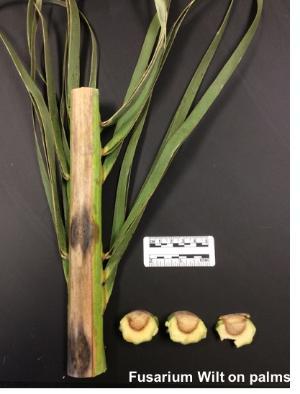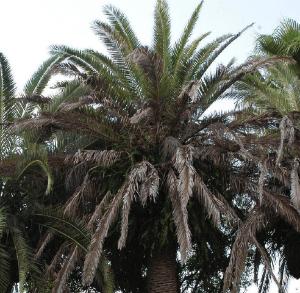Submissions
The Florida Extension Plant Diagnostic Clinic is designed to provide plant disease diagnostic services for anyone interested in plant diseases and insect pests.
Our services include analysis of plant material for bacterial, fungal, viral, and nematode pathogens as well as the identification of insect pests. All diagnoses include appropriate control measures when available.
For proper diagnosis, specimens must be received in good condition and should contain enough material. Include accompanying information (such as photos, etc.) regarding the symptoms that are of particular concern to you. Hand-deliver samples, if possible, or send by the fastest means available (Federal Express, UPS, and/or Priority Mail through the U.S. Postal Service) directly to the building.
-
Specimen Submission Guidelines
Complete the Plant Diagnostic Clinic Submission Form (o Formulario de Envio de Muestras), or the Insect Identification form as completely as possible. This form must accompany each specimen sent to the lab. The information supplied will allow a more thorough and accurate diagnosis. Include your phone number and e-mail, so we may contact you for further information or inform you of the diagnosis. Each diagnosis includes a written report with pest management strategies that are research based and environmentally appropriate for the situation. Process time ranges from 7-10 business days, depending on the sample.
Please do not send plants that are completely dead. Please do not send soil alone: we do not test soil for fungal or bacterial pathogens.
1) Disease Samples: Take samples before applying pesticides, otherwise the ability to recover pathogens may be limited. Send several plants/leaves/branches etc. showing a range of symptoms that are representative of the problem. Select samples from the area at the margin between the diseased portion of the plant and the healthy tissue. Dead plant material is of no diagnostic value because it contains secondary organisms that make detection of the primary pathogen difficult
- Place leaves, branches, and other plant parts in a plastic bag and seal it. Do not add moist towels or moisten the sample before sealing it.
- When sending entire plants, dig, rather than pull, roots from the soil. Wrap roots and attached soil in a plastic bag and secure to the trunk with a twist tie. Place a second bag over the foliage and punch a few holes through this bag for ventilation. Do not add additional water or moist towels.
- Vascular wilt specimens: Plants or plant parts that suddenly wilt may be infected with a vascular disease. Branch or stem sections should be taken from the wilting plant or recently wilted plant part. Avoid sending plant material that has been dead for any length of time.
- For more details, view the sample submission guide for plant diagnostic clinics of the Florida plant diagnostic network.
2) Insect Samples: Immature and soft-bodied insects should be placed in 70% ethyl alcohol (rubbing alcohol is not ideal, but may work). Other insects must be carefully packaged. Do not place loose insects into envelopes for mailing, as handling mail can destroy the specimens. You can also submit the host plant (containing the pest) inside a sealed bag.
Diagnostic Fees (payment payable to University of Florida):
- General disease analysis - $50*
- Molecular identification of the disease causal agent (identification of the pathogen to species level) - $80
- Insect ID - $8
*Fee applies for routine processing, standard morphological and microscopic diagnosis. Molecular and serological-based diagnostic methods may be available for additional fee.
-
Turf/Grass
-300x300.jpg)
- Submit generous amounts of plant material from the edge of the diseased area representing a range of symptoms (part dead part healthy). Two cup cutter plugs are usually sufficient. Aeration cores are not.
- Don’t add water. Samples should be sealed in plastic bags and may be wrapped in aluminum foil, newspaper, paper towel, etc. before being sealed in a plastic bag.
- Deliver or ship samples via express courier immediately after collecting. Do not send samples if collected more than 12 hrs. prior to shipping. Get new samples.
- All samples must be accompanied by a completed Plant Diagnostic Clinic Submission Form / Formulario de Envio de Muestras. Give complete information on the form and keep the form separate from the sample. Limit sample information to one (1) sample per form. You are encouraged to include any other pertinent information in addition to that requested on the form.
- Samples cannot be received on Saturday or Sunday; ship accordingly.
Other Resources
Dr. Phil Harmon
Turfgrass Pathologist and Extension Specialist with UF IFAS Department of Plant Pathology
Phone: 352 273-4622
Email: pfharmon@ufl.edu- Rapid Turfgrass Diagnostic Service
- Nematode testing
- Learn More through the UF Plant Diagnostic Center
-
Laurel Wilt Disease
FEE: $80
Woody plants in the laurel family (Lauraceae) affected by laurel wilt disease typically have wilted leaves and a black or dark discoloration in the outer sapwood of the main stem or branches. To confirm presence of the laurel wilt pathogen, this discolored sapwood should be collected for analysis. Evidence of ambrosia beetle attack may or may not be present.
If you suspect a plant has laurel wilt disease and would like confirmation of the causal pathogen, please follow these steps to submit a plant sample:
1. Type of sample:
A. If collecting from the main stem of a mature tree: Using a hatchet, hammer & chisel, or knife, remove the bark down to the surface of the sapwood (xylem) and look for discoloration in the wood. Chisel or cut out a few thick chips of the discolored wood.
B. If collecting from small stems or branches with wilted leaves: With a knife, remove bark down to the surface of the sapwood and look for discoloration in the wood. Cut and collect a few short branches or stem sections that contain this discoloration. Small twigs that have been dead a long time and are dry and crispy when broken are not good samples for pathogen confirmation
2. Fill out the sample submission form with information about the sample (type of plant, date collected, exact location of diseased plant, symptoms observed, your name, address and contact information).
3. Put the plant material in a plastic zip-lock bag and the sample submission form in another plastic zip-lock bag. Put all these bags into another bag to keep them together. Tightly seal all bags to prevent the possibility of live insects in the wood from escaping.
4. If you have digital photos of the plant, particularly the damaged portions, from which you took the sample, they can be helpful in deciding how to treat the sample. Please send these photos to trec-pdc@ifas.ufl.edu.
5. Secure the samples in a sturdy box and write “laurel wilt samples” clearly on the outside.
6. Send samples preferably by overnight mail early in the week so they can be quickly processed and don’t sit over the weekend.
-
Fusarium Wilt of Palms

FEE: $80
Field diagnosis can often be made based on the symptoms described above, especially if the symptoms are typical ones. But symptoms of Fusarium wilt look the same as petiole/rachis blight. The latter is not a true vascular wilt and usually does not kill the palm, but the resulting individual leaf symptoms are very similar on Phoenix species. See the fact sheet about this disease. It is also possible for a Canary Island date palm to have both diseases. Therefore, a laboratory diagnosis is required to confirm Fusarium wilt.
To confirm the field diagnosis, a laboratory must isolate a Fusarium oxysporum-like fungus from the affected leaf tissue and then conduct a molecular test on the isolated culture to confirm it is f. sp. canariensis. Contact your local county Extension office or the TREC Plant Diagnostic Clinic (786-217-9276) for complete details about correct sample submission procedures and cost of a laboratory diagnosis. The best tissue to send for a diagnosis is the petiole or rachis from a leaf exhibiting the typical symptoms of one-sided wilt. A dead leaf is not acceptable.
Molecular confirmation of the isolated fungus is critical. There are numerous Fusarium oxysporum isolates that do not cause disease but may be associated with palm material. Unfortunately, it is not possible to separate pathogenic isolates from nonpathogenic isolates based on their appearance in culture. Thus, isolating a fungus that looks like F. oxysporum does not confirm the field diagnosis. The fungus growing on the culture plate must be subjected to a molecular test that is specific for F. oxysporum f. sp. canariensis.
If the field symptoms appear typical for Fusarium wilt, but Fusarium is not isolated, then the symptoms may be an expression of petiole/rachis blight. Many of the petiole/rachis blight pathogens are not culturable from plant tissue. The next step would be to obtain new samples from the diseased palm or similarly diseased palm and resubmit to the clinic to confirm presence or absence of petiole/rachis blight pathogens. Be sure to discuss the problem with the clinic staff before resubmitting samples. If no symptomatic leaves are available, wait until new symptoms develop before resubmitting.
-
Lethal Yellowing and Texas Phoenix Palm Decline

Photo: Monica Elliott, University of FloridaWe currently do not run this sample at the TREC Plant Clinic. Your samples need to be submitted to the UF/IFAS Fort Lauderdale Research and Education Center. Complete a Sample Submission form and send it with the samples in the overnight package.
More Information
Sample Submission
Plant Clinic
UF/IFAS Tropical Research and Education Center
Att. Dr. Romina Gazis
18905 S.W. 280 Street
Homestead, Florida 33031
E-mail: trec-pdc@ifas.ufl.edu
Phone: (786) 217-9276
Office Hours:
Monday - Friday, 8:00 a.m. - Noon
1:00 p.m. - 5:00 p.m.
(closed state and UF holidays)
Submission Forms
- Plant Diagnostic Clinic Submission Form
- Formulario de Envio de Muestras
- Plant Diagnostic Clinic Soil Sample
- Insect Identification form
- Fee Structure_2023
Map and Directions
Note: Please sign-in at the Administration Building upon arrival.

.jpg)